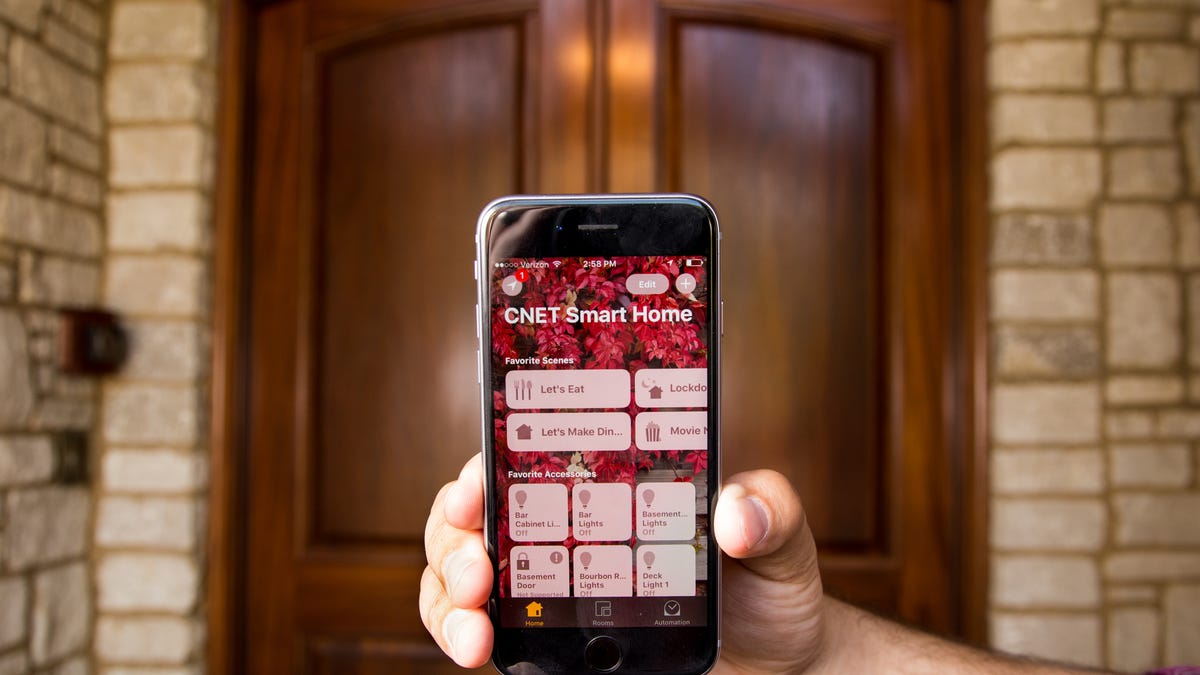 Why You Can Trust CNET
Why You Can Trust CNET Apple HomeKit: Everything you need to know
Get to know the software behind Apple's Siri-powered smart home platform.

"Siri, open my bedroom shades."
You might not know it, but you're using Apple HomeKit every time you issue a smart-home-related voice command on your iPhone, HomePod -- or other Siri-compatible device.
HomeKit is to Apple what Alexa skills are to Amazon, or what actions are to Google. It's that intangible, but vital in-the-background software that makes it possible for you to turn on your smart lights every morning with a simple Siri command (or from Apple's iOS-only Home app).
Read more: Will HomeKit and HomePod get any attention at WWDC?
HomeKit software was introduced way back at WWDC 2014 -- before we had even heard of those now-ubiquitous smart speakers called the Amazon Echo and the Google Home. Still, HomeKit and the HomePod smart speaker aren't nearly as well known as their competitors. Here's a close-up look at Apple HomeKit -- what it is, why it matters and how it fits into the growing smart home landscape.
A brief chronology
The timeline for HomeKit is important because it helps explain how Amazon and Google gained ground so quickly -- even though they technically joined the smart home market after Apple. Take a look:
June 2014 - Apple announces HomeKit at WWDC, but no accompanying smart speaker and keeps it closed to developers
November 2014 - Amazon introduces the Amazon Echo, along with Alexa, Alexa skills and the Alexa app
June 2015 - The first batch of HomeKit-enabled devices hit stores, updated with MFi chips as part of Apple's certification program
September 2016 - Apple introduces the Home app for adding HomeKit devices and controlling them from your phone
October 2016 - Google introduces the Google Home, along with Google Assistant, Google actions and the Google Home app
February 2018 - Apple introduces the HomePod, the first Apple smart home speaker, nearly four years after HomeKit
Between November 2014 and February 2018, Amazon and Google also added additional smart speakers to their device lineup. Amazon's smart speakers range from the $50 (£50, AU$79) Echo Dot to the $230 (£200 or roughly AU$300 converted) Echo Show. Google's range from the $50 (£50, AU$80) Home Mini to the $399 Home Max (not yet available internationally, but we predict a £399 and AU$599 price when it is).
Taking a look at HomeKit's competition
| Apple | Amazon | ||
| Software | HomeKit (closed) | Skills (open) | Actions (open) |
| Voice assistant | Siri (iOS only) | Alexa (Android and iOS) | Google Assistant (Android and iOS) |
| Device(s) | Apple HomePod | Amazon Echo (among others) | Google Home (among others) |
| Mobile app | Home (iOS only) | Alexa (Android and iOS) | Google Home (Android and iOS) |
Open or closed?
There's a reason HomeKit isn't as well known as Alexa skills or Google actions.
Unlike Amazon, which opened up its Alexa skills to developers early on (the same goes for Google actions), Apple has maintained control of HomeKit from day one. Outside commercial developers can't create Siri-voice-powered integrations for their connected devices. Also, Apple previously required third-party companies requesting integration with Siri to install a piece of hardware called an MFi chip in their devices.
The MFi chip is no longer required, but HomeKit hopefuls still have to go through the MFi certification program to apply for integration with Siri.
Largely because of its closed-off nature, HomeKit hasn't advanced as quickly as its competitors. Here's where you can find all of the devices that work with Apple HomeKit.
Home
HomeKit lives in the iOS-only Home app. It's the place where you pair new compatible devices, assign them to rooms in your house and create custom "scenes" (if you want) like "Good morning." "Good morning" might turn on your bedroom lights, adjust the living room thermostat and open all of the window shades -- simultaneously.
You can either enable your "Good morning" scene from the Home app or ask Siri to do it on your iOS device or on a HomePod smart speaker.
Adding a HomeKit device to the Home app (see the screenshot above) involves scanning a special code included with your purchase. It's typically printed on a sticker on the device itself.
Unlike Amazon or Google, Apple's Home app wasn't introduced until two years after HomeKit was first announced. The earliest HomeKit integrations, unsurprisingly, were confusing to configure because there was no mobile app to launch them from. You instead had to connect them through the third-party device's native app, which didn't always follow a standardized process.
The outlook
Apple finally has all of the main pieces it needs to be a comprehensive smart home platform -- HomeKit, Siri, the HomePod and the Home app. Why it took the tech giant four years between introducing HomeKit and actually offering a smart speaker to accompany it is less clear. Either way, there are still a couple of things Apple could do to grow the customer base of HomeKit: a Home app for Android customers and a HomeKit SDK that's completely open to developers (another thing that was reportedly in the works, but is currently only available to MFi licensees) -- but I'm not holding my breath.
Considering the open nature of Alexa skills and Google actions, Apple has a lot of catching up to do. We'll continue to track HomeKit's progress and provide updates as soon as we hear about them, which could be as early as Monday (June 4) -- Apple's WWDC keynote kicks off at 10 a.m. PT/1 p.m. ET.

